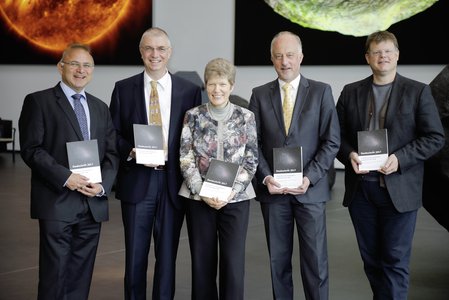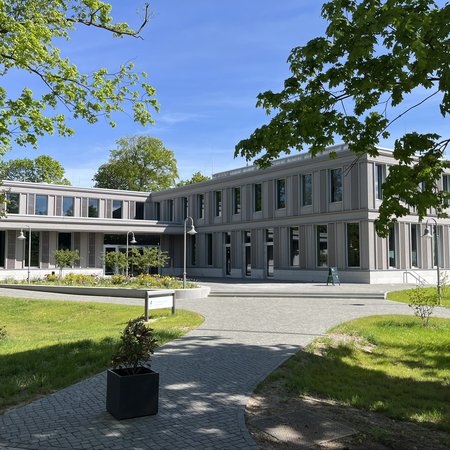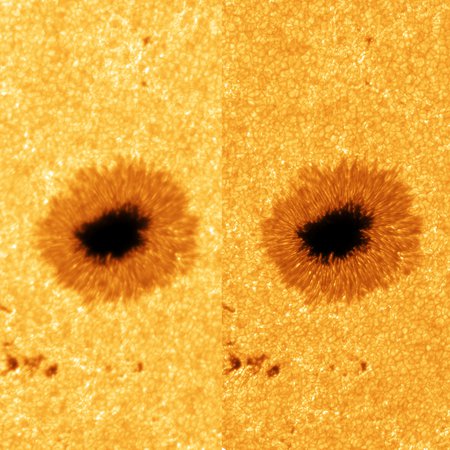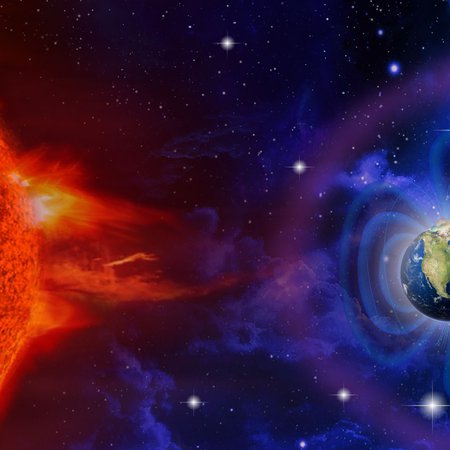Perspectives of Astrophysics in Germany from 2017 to 2030
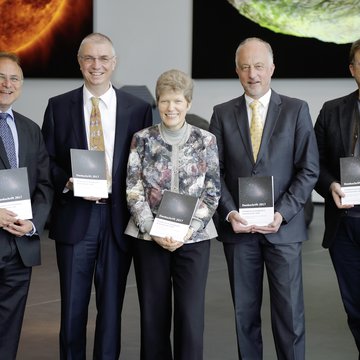
Presentation of the "Denkschrift 2017" at the annual meeting of the German Astronomical Society 2017. Full caption in the text.
Credit: Thomas KlawunnAt the annual meeting of the German Astronomical Society 2017, the Council of German Observatories presented the Denkschrift 2017 “Perspectives of astrophysics in Germany 2017-2030: From the beginnings of the cosmos to clues for life on extrasolar planets“. In this publication, the Council of German Observatories (in German: Rat Deutscher Sternwarten, or RDS for short) gives an overview of the status of the field of astronomy and astrophysics, presents the main scientific questions and lays out the structures needed to further promote the field. The RDS recommends for example the participation of Germany in the construction and further development of major observatories such as the Extremely Large Telescope and other observatories by the European Southern Observatory (ESO) in Chile, the Square Kilometre Array in South Africa and Australia, and the European Solar Telescope on Tenerife. The RDS supports a strong German investment in space research, especially within the national space program.
The so-called „Denkschriften“ (in content and scope comparable to the decadal report in the US) by the astronomical and astrophysical community have become a kind of tradition in Germany – the previous ones appeared in 1962, 1987, and 2003, and have had considerable science-political influence. “The many breakthroughs of the past decades have only been possible owing to the access to exquisite research infrastructures on the ground and in space,” says Prof. Dr. Matthias Steinmetz, Scientific Director of the Leibniz Institute for Astrophysics Potsdam (AIP), president of the German Astronomical Society (in German: Astronomische Gesellschaft) and coordinator of the Denkschrift 2017.
The quintessence of the Denkschrift are the recommendations regarding the participation of Germany in the most important international telescope projects and observatories. In the first place, this involves observatories such as the ESO’s Extremely Large Telescope, which with a mirror diameter of 39 meters will be the “biggest eye on the sky”, as well as the planned facilities on the European Infrastructure Roadmap, such as the radio telescope project Square Kilometre Array (SKA) and the European Solar Telescope (EST). In space science, missions of ESA’s Cosmic Vision program are especially important. Astronomers in Germany actively participate in many of these projects, often in leading positions. In addition to the European ground-based and space-based observatories, individual and bilateral projects should be pursued – especially considering the long-term nature of these projects and in order to keep the specialists of the different disciplines in Germany.
The Denkschrift 2017 is also available online at:
www.denkschrift2017.de
As to primarily address the science-political landscape and decision makers in Germany, the document is written in German. At the beginning, however, there is an Executive Summary in English. The Denkschrift 2017 is based on 20 strategy papers in English that are also published on the website.
Original press release by the German Astronomical Society (in German): www.astronomische-gesellschaft.de/de/aktivitaeten/pressemitteilungen/pmdenk
Science contact: Prof. Dr. Matthias Steinmetz, +49 331-7499 801, msteinmetz@aip.de
Media contact: Dr. Janine Fohlmeister, +49 331-7499 803, jfohlmeister@aip.de
Image: From the left to the right: Prof. Dr. Sami K. Solanki (Director of the Max Planck Institute for Solar System Research), Prof. Dr. Matthias Steinmetz (President of the German Astronomical Society), Prof. Dr. Eva Grebel (Director of Astronomisches Recheninstitut at the Centre for Astronomy of Heidelberg University), Prof. Dr. Joachim Wambsganß (Vice President of the German Astronomical Society) und Prof. Dr. Jörn Wilms (University Erlangen-Nürnberg) presenting the Denkschrift 2017. (Photograph by: Thomas Klawunn)
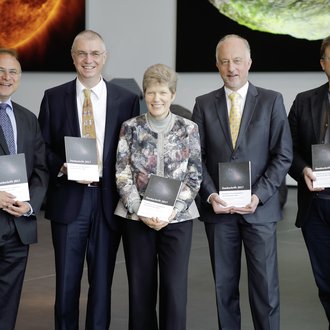
Presentation of the "Denkschrift 2017" at the annual meeting of the German Astronomical Society 2017. Full caption in the text.
Credit: Thomas KlawunnAt the annual meeting of the German Astronomical Society 2017, the Council of German Observatories presented the Denkschrift 2017 “Perspectives of astrophysics in Germany 2017-2030: From the beginnings of the cosmos to clues for life on extrasolar planets“. In this publication, the Council of German Observatories (in German: Rat Deutscher Sternwarten, or RDS for short) gives an overview of the status of the field of astronomy and astrophysics, presents the main scientific questions and lays out the structures needed to further promote the field. The RDS recommends for example the participation of Germany in the construction and further development of major observatories such as the Extremely Large Telescope and other observatories by the European Southern Observatory (ESO) in Chile, the Square Kilometre Array in South Africa and Australia, and the European Solar Telescope on Tenerife. The RDS supports a strong German investment in space research, especially within the national space program.
The so-called „Denkschriften“ (in content and scope comparable to the decadal report in the US) by the astronomical and astrophysical community have become a kind of tradition in Germany – the previous ones appeared in 1962, 1987, and 2003, and have had considerable science-political influence. “The many breakthroughs of the past decades have only been possible owing to the access to exquisite research infrastructures on the ground and in space,” says Prof. Dr. Matthias Steinmetz, Scientific Director of the Leibniz Institute for Astrophysics Potsdam (AIP), president of the German Astronomical Society (in German: Astronomische Gesellschaft) and coordinator of the Denkschrift 2017.
The quintessence of the Denkschrift are the recommendations regarding the participation of Germany in the most important international telescope projects and observatories. In the first place, this involves observatories such as the ESO’s Extremely Large Telescope, which with a mirror diameter of 39 meters will be the “biggest eye on the sky”, as well as the planned facilities on the European Infrastructure Roadmap, such as the radio telescope project Square Kilometre Array (SKA) and the European Solar Telescope (EST). In space science, missions of ESA’s Cosmic Vision program are especially important. Astronomers in Germany actively participate in many of these projects, often in leading positions. In addition to the European ground-based and space-based observatories, individual and bilateral projects should be pursued – especially considering the long-term nature of these projects and in order to keep the specialists of the different disciplines in Germany.
The Denkschrift 2017 is also available online at:
www.denkschrift2017.de
As to primarily address the science-political landscape and decision makers in Germany, the document is written in German. At the beginning, however, there is an Executive Summary in English. The Denkschrift 2017 is based on 20 strategy papers in English that are also published on the website.
Original press release by the German Astronomical Society (in German): www.astronomische-gesellschaft.de/de/aktivitaeten/pressemitteilungen/pmdenk
Science contact: Prof. Dr. Matthias Steinmetz, +49 331-7499 801, msteinmetz@aip.de
Media contact: Dr. Janine Fohlmeister, +49 331-7499 803, jfohlmeister@aip.de
Image: From the left to the right: Prof. Dr. Sami K. Solanki (Director of the Max Planck Institute for Solar System Research), Prof. Dr. Matthias Steinmetz (President of the German Astronomical Society), Prof. Dr. Eva Grebel (Director of Astronomisches Recheninstitut at the Centre for Astronomy of Heidelberg University), Prof. Dr. Joachim Wambsganß (Vice President of the German Astronomical Society) und Prof. Dr. Jörn Wilms (University Erlangen-Nürnberg) presenting the Denkschrift 2017. (Photograph by: Thomas Klawunn)
Images
Presentation of the "Denkschrift 2017" at the annual meeting of the German Astronomical Society 2017. Full caption in the text.
Big screen size [1000 x 666, 100 KB]
Original size [3543 x 2362, 780 KB]
